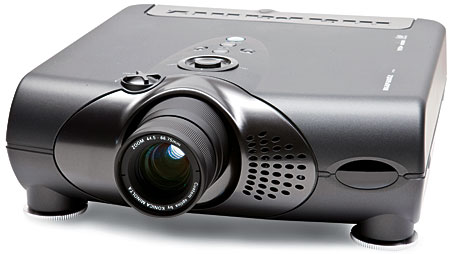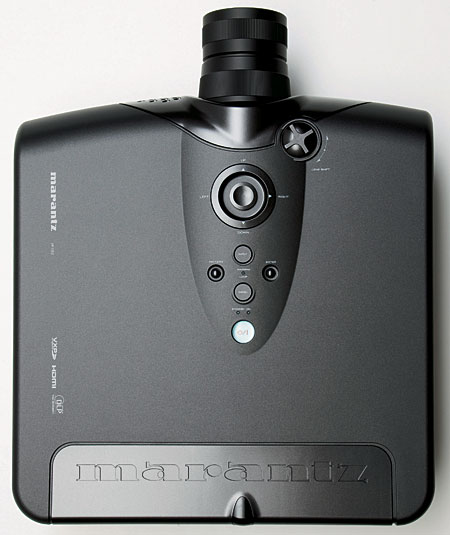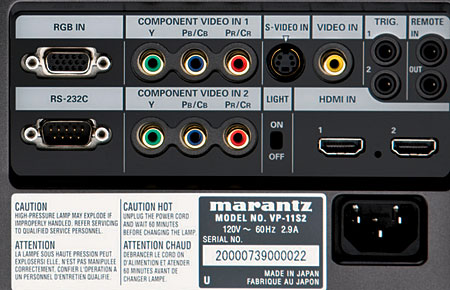Marantz VP-11S2 DLP Projector

Outside In
Upon a cursory inspection, the VP-11S2 and previous-generation VP-11S1 are almost identical. The logos are positioned slightly differently, and the trim is a darker black on certain parts of the body.
As with the VP-11S1, Marantz uses a custom-made Konica/Minolta lens and a rugged chassis that is both heavy and elegant. Two lenses are available: short-throw and long-throw (at extra cost). For this review, I received the long-throw lens.

Marantz recently announced that it has implemented a new coating on the short-throw lens that is claimed to increase the already superb ANSI contrast performance to 1000:1, which is higher than any projector I'm aware of. Marantz has used this coating on its long-throw lenses, including the one on my review sample, for some time, but it was recently incorporated into the short-throw lens as well. If you're looking at the short-throw version, you should confirm that your sample has the new coating.
The VP-11S2's lens is hand-picked for optimum quality. The VP-11S1 was easily one of the sharpest projectors I've ever used, and the VP-11S2 continues that level of performance with its outstanding pixel clarity and focus uniformity. Chromatic aberration was virtually a non-issue—I saw only a hint of it with red at the extreme ends of the image, similar to what I saw with the VP-11S1. Focus uniformity was excellent across my screen, and per-pixel focus was dead on. I could easily make out the dimple in the center of each micromirror pixel on the screen.
The back panel is identical to that on the VP-11S1. This includes a small light that helps you make connections in a dark room, which is very convenient. Inputs include two HDMI 1.3, two component, and one D-sub 15-pin connector for RGB-HV. For the custom installer, Marantz added an RS-232 connection, two 12-volt triggers for automation, and a remote interface.

The VP-11S2 employs Texas Instruments' latest 1920x1080 DarkChip 4 DMD (Digital Micromirror Device) chip, which boasts a 30-percent increase in specified chip-level contrast over DarkChip 3. Marantz hand picks DMDs for the best performance. I've heard from several other projector manufacturers that there are indeed varying degrees of quality when it comes to DMDs. The color wheel is also a bit different—you can adjust it for speed, with the option of 4x, 5x, or 6x. This helps viewers with sensitivity to the "rainbow effect," which arises from the use of a color wheel to separate red, green, and blue.
Another big design change is in its optical path. The VP-11S1 used a single iris combined with filtering in the color wheel to act as a pseudo second iris. This new design uses two physical irises, one near the lamp and the other near the lens. It offers three fixed positions for the iris system. There is a shutdown position that provides the best contrast performance but lower light output, a midpoint for a mix of good contrast and higher light output, and an open position that maximizes light output. The VP-11S2 is a slightly brighter projector than the VP-11S1. Even when I used the tightest iris setting, it still delivered enough light for my 120-inch (diagonal) Stewart Filmscreen StudioTek 130 screen. Note that my room is completely dark and has 100-percent light control and few or no reflective surfaces.
Setup
Installing the Marantz was quite easy. The VP-11S2 includes a manual horizontal lens-shift option and a manual lens focus. The lens shift worked nicely, and I didn’t have any slip issues like I’ve seen on some other designs. I still prefer a powered focus option, since it lets you focus the projector right at the screen. But that didn’t keep me from getting a perfectly uniform focus across the entire screen.
- Log in or register to post comments




































































